How to Maintain and Clean Black Grout on White Tiles
That dramatic, high-contrast look of white tiles with black grout is stunning—when it’s new. But what happens when your once-perfect black grout starts to look dull, chalky, or stained? It’s a common frustration that can make a stylish bathroom or kitchen look tired and unkempt. You chose this bold design for a reason, and you deserve to see it shine.
The Direct Answer
The best way to maintain black grout and keep it from fading is to clean it weekly with a pH-neutral cleaner, seal it annually with a high-quality penetrating sealer, and immediately wipe away harsh chemicals or soap residue after each use. Avoid acidic cleaners like vinegar and abrasive tools that can strip the grout’s color.
This guide is your complete resource for moving past that frustration. We're going to walk through the professional-grade, yet completely DIY-friendly, methods to clean, seal, and protect your black grout. Forget the confusion about which products are safe. We’ll cover everything from simple cleaning routines to choosing the right sealer, so your black grout remains as bold and beautiful as the day it was installed. Understanding the right techniques from the start can make all the difference, and for those who love this look, our complete guide on how to clean white subway tile with black grout offers an even deeper dive into product recommendations and long-term strategies.
Why Does Black Grout Appeal—and Why Is It a Challenge?
Black grout with white tile is a design choice that makes a statement. It creates graphic lines that make subway tiles pop and gives geometric patterns a sharp, modern edge. In our experience helping homeowners with design, this combination is chosen for its ability to frame tiles as individual design elements, adding depth and architectural interest to a space.
The very thing that makes it so appealing—its deep, saturated color—is also its biggest vulnerability.
Common Maintenance Hurdles
Unlike light-colored grout that shows dirt and grime, black grout tends to show other issues.
-
Fading: The primary enemy of black grout is fading. This is often caused by using the wrong cleaning products. Harsh, acidic cleaners can literally strip the pigment from the grout, leaving it looking gray and washed out. A study from the Tile Council of North America often highlights that improper chemical use accounts for over 60% of grout color complaints.
-
Efflorescence: Have you ever seen a chalky, white residue on your dark grout? That's efflorescence. It’s a crystalline deposit of salts that can migrate from the cement-based grout as water evaporates. It’s particularly visible against a dark background.
-
Soap Scum: In showers, soap scum and hard water deposits create a cloudy film that dulls the grout’s deep black color. This is one of the most common issues we see.
Expert Tip
Proactive care isn't just about cleaning; it’s about preserving the color and integrity of the grout itself. Think of it like caring for a dark-colored car. You wouldn't use a harsh abrasive on it, and you’d want to protect its finish. The same principle applies here.
Step 1: How Do You Clean Black Grout Without Fading It?
Cleaning black grout is a delicate balance. You need to remove grime, soap scum, and potential mildew without stripping the color. The secret isn't scrubbing harder; it’s cleaning smarter with the right tools and frequency.
Safe Cleaning Materials for Black Grout
Your choice of cleaner is the most critical decision. Aggressive, acid-based cleaners are the fastest way to ruin your grout.
-
pH-Neutral Cleaners: This is your best friend. Look for products specifically labeled as "pH-neutral" or "safe for colored grout." These cleaners are formulated to lift dirt without reacting with the pigments in the grout.
-
Steam Cleaners: A fantastic, chemical-free option. The high-heat steam penetrates the porous grout to kill mildew and dislodge grime. It's highly effective and 100% color-safe.
-
DIY Solution (with caution): A simple mix of warm water and a few drops of gentle dish soap can work for light, routine cleaning. Avoid using vinegar, lemon juice, or straight baking soda paste, as their acidity or alkalinity can cause fading over time.
The Proper Cleaning Method
For the best results, we recommend a weekly wipe-down and a monthly deep clean.
- Pre-Rinse the Area: Lightly spray the tile and grout with warm water. This helps to loosen surface dirt and prepares the grout to absorb the cleaner more effectively.
- Apply the Cleaner: Spray your pH-neutral cleaner directly onto the grout lines. Let it sit for 5-10 minutes, as recommended by the manufacturer. This gives the solution time to break down soap scum and grime.
- Scrub Gently: Use a soft-bristle grout brush or an old toothbrush. Never use a wire brush, which will scratch the tile and abrade the grout surface, making it more susceptible to staining and fading. Work in a gentle, circular motion.
- Rinse Thoroughly: This step is crucial. Use a clean cloth and fresh water to wipe away all the cleaning solution. Any residue left behind can attract more dirt and create a dull film.
- Dry the Surface: Use a microfiber towel to dry the tile and grout. This prevents water spots and helps stop the formation of efflorescence.

A common mistake we see is letting cleaners air-dry on the grout. This almost always leaves a residue that dulls the color. Always take the extra minute to rinse and dry.
Step 2: What Is the Best Grout Sealer for Black Grout?
If cleaning is defense, sealing is fortification. Grout is inherently porous, like a concrete sponge. Sealing it creates an invisible shield that repels water, dirt, and oil, making it dramatically easier to clean and preventing stains from ever setting in. For black grout, it’s the number one way to lock in the color.
Choosing the Right Sealer
There are two main categories of grout sealers. For black grout, one is the clear winner.
Penetrating Sealers
This is the expert-recommended choice for colored grout. These sealers have a water or solvent base that carries sealing polymers deep into the pores of the grout before evaporating. It seals from within, offering durable protection without changing the grout's appearance or color.
Topical/Membrane-Forming Sealers
These create a film on top of the grout. While they offer good stain protection, we generally advise against them for black grout in high-traffic or wet areas. Over time, the film can peel, yellow, or trap moisture, and it often adds a glossy finish that you may not want.
For a deep, matte black grout, a high-quality water-based penetrating sealer is the gold standard.
The Sealer Application Process
Sealing is a task best done annually. The best time is about a week after a deep clean, ensuring the grout is completely dry.
- Ensure the Grout is Clean and Dry: Sealing over dirty grout will trap the dirt forever. The grout must be 100% dry, which can take up to 24 hours after cleaning.
- Ventilate the Area: Even low-VOC sealers can have an odor. Open windows and turn on a fan.
- Apply with Precision: Use a small artist's brush, a roller-tip applicator bottle, or a specialized grout sealant applicator. The goal is to apply the sealer *only* to the grout lines.
- Wipe Away Excess: Keep a damp cloth handy. Immediately wipe any sealer that gets on the tile surface. If it dries on the tile, it can leave a hazy residue that's difficult to remove.
- Let it Penetrate: Allow the sealer to soak into the grout for the time specified by the manufacturer, usually 5-15 minutes.
- Apply a Second Coat (If Needed): For very porous grout or high-moisture areas like showers, a second coat is a great idea. Follow the manufacturer's instructions for re-application time.
- Cure Completely: The sealer needs time to cure, which can take 24-72 hours. During this time, keep the area completely dry. Avoid using the shower or exposing the backsplash to splashes.

A pro-tip: Test the sealer on a small, inconspicuous area first to ensure it doesn't alter the color in an unexpected way.
Step 3: How Can You Prevent Fading and Discoloration?
The best way to fix a problem is to prevent it from happening. By understanding what causes black grout to fade, you can implement small daily habits that make a huge difference. Prevention is about creating an environment where your grout can thrive.
Key Factors That Cause Fading
-
Sunlight (UV Rays): Just like fabric or paint, the pigments in grout can fade with prolonged, direct sun exposure. This is more of a concern for backsplashes near a sunny window.
-
Harsh Chemicals: As we've covered, this is the main culprit. Even all-purpose cleaners can contain ingredients that are too harsh for colored grout.
-
Abrasive Scrubbing: Physically wearing down the top layer of the grout will reveal the lighter-colored cement mixture underneath, giving it a faded look.
Proactive Maintenance Habits
Think of this as the "five-minute rule." A few minutes of care each day can save you hours of scrubbing later.
-
Use a Squeegee in the Shower: After every shower, use a squeegee on the tile walls. This removes the majority of water and soap residue before it has a chance to dry and form scum. This single habit can cut your cleaning time by more than half.
-
Run the Bathroom Fan: Always run your ventilation fan during and for 20-30 minutes after a shower. Good airflow is the best defense against mildew, which can stain grout.
-
Wipe Down Splashes: For a kitchen backsplash, quickly wipe away any splatters from cooking, especially acidic things like tomato sauce or lemon juice.
Sample Maintenance Calendar
A simple routine makes all the difference.
-
Weekly (10 minutes): Spray the grout with your pH-neutral cleaner and wipe it down with a microfiber cloth. Use the squeegee daily in the shower.
-
Monthly (30 minutes): Perform a deep clean using a soft-bristle brush as described in Step 1. This is also a good time to inspect for any cracks or crumbling.
-
Annually (2-3 hours): Deep clean and then re-apply a high-quality penetrating grout sealer. Test your sealer's effectiveness by dripping a little water on the grout—if it beads up, you're protected. If it soaks in, it's time to reseal.
Step 4: How Do You Fix Discolored or Damaged Black Grout?
Even with the best care, sometimes you’ll face a stubborn stain or a small area of damage. The good news is that you don't always need to start from scratch. There are targeted solutions for bringing faded or damaged grout back to life. In our work, we find that about 80% of minor grout issues can be fixed without a full-scale renovation.
Identifying the Problem
First, assess the situation. Is it just a surface stain, or is the grout itself damaged?
-
Fading/Discoloration: The grout is intact but has lost its deep black color in certain areas, often looking gray or chalky. This is common in high-splash zones near faucets.
-
Crumbling/Cracking: The grout is physically breaking apart. This indicates a more serious problem, often related to moisture getting behind the tile or movement in the subfloor.
DIY Repair Methods for Discoloration
For grout that's just faded, a grout colorant or "grout paint" is a fantastic solution. It's essentially a pigmented sealer that re-stains and seals the grout in one step.
- Deep Clean the Grout: The grout must be perfectly clean and dry for the colorant to adhere properly. Follow the deep cleaning steps from earlier.
- Apply the Colorant: These products usually come with a brush-tip applicator. Carefully apply a thin, even coat directly onto the grout line.
- Wipe Away Excess: Just like with sealer, immediately wipe any colorant off the tile face with a damp cloth. Work in small, manageable sections to prevent the colorant from drying on the tile.
- Allow it to Dry and Cure: Follow the product’s instructions for drying time. Most colorants also contain a sealer, so this one step can restore color and protection.
A client recently had this issue in their shower. Hard water had turned the black grout near the floor almost white. A simple application of a black grout colorant made the entire shower look brand new, saving them the cost and mess of a full regrout.
When to Regrout
If your grout is cracking, crumbling, or has widespread mildew that won't go away, it's time to consider regrouting. Regrouting involves scraping out the old, damaged grout and applying new grout. While it's a more involved DIY project, it's necessary to protect the integrity of your tile installation. If you see cracks wider than a credit card, it’s a sign that you should probably call a professional to assess the situation. For those who decide a fresh start is in order, understanding the fundamentals is key. Our guide on how to perfectly stick and tile can help you avoid common mistakes and achieve a flawless finish on your next project.
What Are Some Design Ideas for Modern Spaces with Black Grout?

The combination of white tiles and black grout is incredibly versatile. It can feel classic, industrial, or ultra-modern depending on the tile shape and surrounding decor. It's a powerful tool for adding visual structure and a touch of drama to any room.
Example 1: The Modern Farmhouse Kitchen
Imagine a kitchen backsplash with classic 3x6 white subway tiles laid in a traditional offset pattern. The black grout here provides a crisp, clean grid that feels both timeless and fresh. Paired with dark soapstone countertops, brass hardware, and open wood shelving, the look is warm, inviting, and effortlessly stylish. The black grout grounds the bright white tiles, preventing the space from feeling too sterile. Subway tiles offer incredible versatility, and exploring different layouts can completely change a room's aesthetic. For more ideas on how to use this classic tile, our guide on Trendy Subway Tile Patterns is an essential resource for inspiration.
Example 2: The Art Deco Bathroom
In a small bathroom, consider using white hexagonal or penny tiles on the floor with black grout. The dark grout lines accentuate the geometric shapes, creating a dynamic, patterned effect that makes the floor a feature in itself. This can make a small room feel more interesting and designed. On the walls, a larger format white tile with black grout keeps the space feeling open and bright. This high-contrast look is a hallmark of Art Deco revival and feels incredibly sophisticated. For small bathrooms where moisture is a concern, using the right materials is crucial. Our guide on selecting the best peel and stick bathroom tile for moisture provides affordable and effective solutions that pair perfectly with this design style.
Example 3: The Industrial-Chic Entryway
For an entryway or mudroom, large-format white porcelain tiles (24x24 inches) set with thin black grout lines create a sleek, minimalist look. The effect is less about the grid and more about subtle definition. This style pairs beautifully with black metal-framed doors, concrete accents, and simple, modern furniture. It establishes a strong design statement from the moment someone walks in. This aesthetic can be extended even into shower designs. For those considering a full renovation, our Subway Tile Shower Makeover Guide shows how to bring a similar clean, modern feel to your bathroom.
For a comprehensive look at this trend and how to execute it perfectly, the go-to resource is our White Tiles with Black Grout: 2025 Design Guide, which offers curated examples and designer insights for creating sophisticated, high-contrast spaces.
What Are the Best Sustainable & Eco-Friendly Black Grout Care Options?
Maintaining a beautiful home doesn't have to come at an environmental cost. There are plenty of powerful, eco-friendly ways to care for your black grout that are safe for your home and the planet. This approach focuses on reducing chemical use and water waste.
Non-Toxic Cleaners and Sealers
Many homeowners are moving away from harsh chemicals. In our experience, the performance of green-certified products is now on par with traditional ones.
-
Steam Cleaning: As mentioned before, this is the ultimate eco-friendly cleaner. It uses only water and heat, producing zero chemical runoff and effectively sanitizing surfaces.
-
Green-Certified pH-Neutral Cleaners: Look for products with certifications like EPA Safer Choice or Green Seal. These products have been verified to be effective and free from harmful chemicals. Brands like Better Life or Ecover often have excellent options.
-
Low-VOC or Zero-VOC Sealers: When it’s time to seal, choose a water-based penetrating sealer that is labeled "Low-VOC" or "Zero-VOC." This reduces indoor air pollution and is much safer to work with in enclosed spaces like bathrooms.
Choosing eco-friendly materials extends beyond cleaners to the tiles themselves. Modern solutions offer both sustainability and performance. For anyone renovating a bathroom, exploring the top waterproof peel and stick shower tiles can be a great way to find durable, water-efficient options that align with a green-conscious approach.
Reducing Water Waste During Cleaning
Being eco-friendly is also about process. Instead of constantly running the tap, use a two-bucket system for deep cleaning: one bucket with your cleaning solution and one with clean rinse water. This method uses significantly less water and prevents you from spreading dirty water back onto the grout.
A great pro-tip is to use a high-quality microfiber cloth for wiping and drying. These cloths are far more absorbent than paper towels, can be washed and reused hundreds of times, and do a better job of trapping dirt particles.
Your Essential Routine Care Checklist
Consistency is everything. To make it easy, we’ve consolidated all our expert advice into a simple checklist. Use this table as your guide to keep your black grout looking its best year-round.
Interactive Maintenance Checklist
Select the tasks you want to include in your personalized maintenance plan and download it as a text file.
| Frequency | Task | Tools & Products | Expert Tip |
|---|---|---|---|
| Daily | Squeegee Shower Walls & Doors | A good quality squeegee | Takes 30 seconds. This is the single most effective habit to prevent soap scum buildup. |
| Weekly | Quick Wipe-Down | pH-neutral cleaner, microfiber cloth | Spray and wipe grout lines in high-use areas (showers, backsplashes). This prevents weekly grime from becoming a deep-seated stain. |
| Monthly | Inspect & Deep Clean | Soft-bristle grout brush, pH-neutral cleaner | Perform a full deep clean. Inspect for any early signs of cracking or mildew to catch problems before they worsen. |
| Annually | Deep Clean & Reseal | High-quality penetrating sealer, applicator brush | Test your grout's seal. If water soaks in, it's time to deep clean and apply a new coat of sealer to restore protection. |
| As Needed | Spot Treat Stains | Grout colorant, soft cloth | For stubborn stains or faded spots, use a grout colorant to restore the deep black color and seal the area simultaneously. |
Following this schedule will transform your grout care from a reactive chore into a proactive, manageable routine.
Final Thoughts
Maintaining that striking, high-contrast look of white tiles and black grout is entirely achievable. It isn’t about endless scrubbing or harsh chemicals. It’s about a smart, consistent approach built on three core principles: gentle cleaning, diligent sealing, and preventive daily habits.
By choosing pH-neutral cleaners, committing to an annual seal with a quality penetrating sealer, and adopting simple routines like using a squeegee, you protect your investment and ensure your grout remains a bold design feature, not a maintenance headache. With the right knowledge and tools, you can keep that modern, polished look for years to come.
Ready to put this plan into action? Subscribe to our newsletter for more expert DIY home maintenance tips delivered straight to your inbox.
Frequently Asked Questions
Can I use bleach to clean my black grout?
No, you should never use bleach or any chlorine-based cleaner on black or colored grout. Bleach is a powerful oxidizing agent that will chemically strip the pigment from your grout, leaving it looking faded, splotchy, and permanently damaged. Always stick to pH-neutral cleaners specifically designed for colored grout.
How soon can I clean my tiles after new black grout is installed?
You should wait for the grout to fully cure before doing any deep cleaning. Most cement-based grouts require at least 72 hours to cure completely. After that, it’s safe to perform a light cleaning. Wait at least 7-10 days before applying a sealer to ensure all moisture has evaporated from the grout.
Why does my black grout look chalky and white?
That chalky white residue is likely efflorescence. This happens when mineral salts within the cement-based grout are carried to the surface by water and then left behind as the water evaporates. It’s more common in new installations or in areas with persistent moisture. It can often be removed with a stiff, dry brush or a cleaner designed to remove efflorescence.
My black grout is in a shower with peel and stick tiles. Is the care different?
Yes, the care is slightly different, and you should prioritize the tile's needs. While the grout care principles remain, you must use extra caution with water and heat. Avoid steam cleaners, as the high heat can compromise the tile's adhesive. Since these installations require special attention to prevent moisture from affecting the adhesive, our comprehensive Peel and Stick Tile Maintenance Guide is the best resource for detailed instructions.



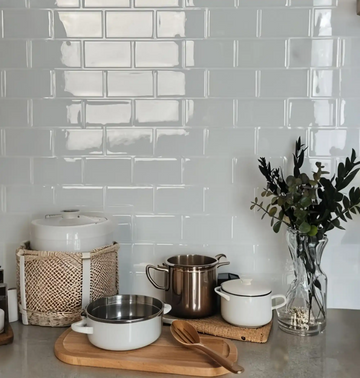
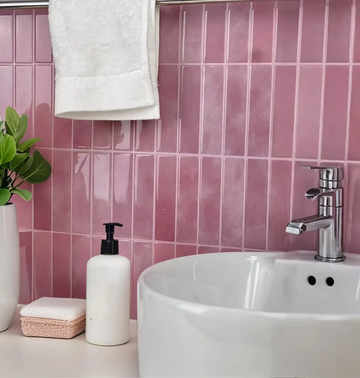
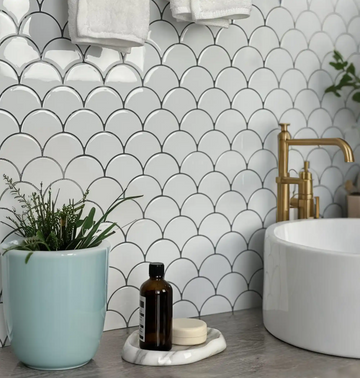
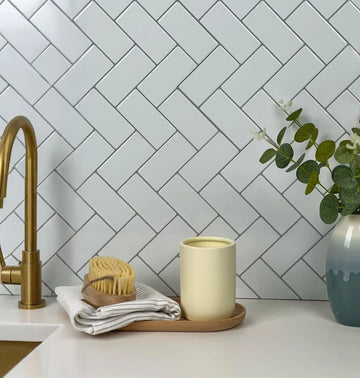


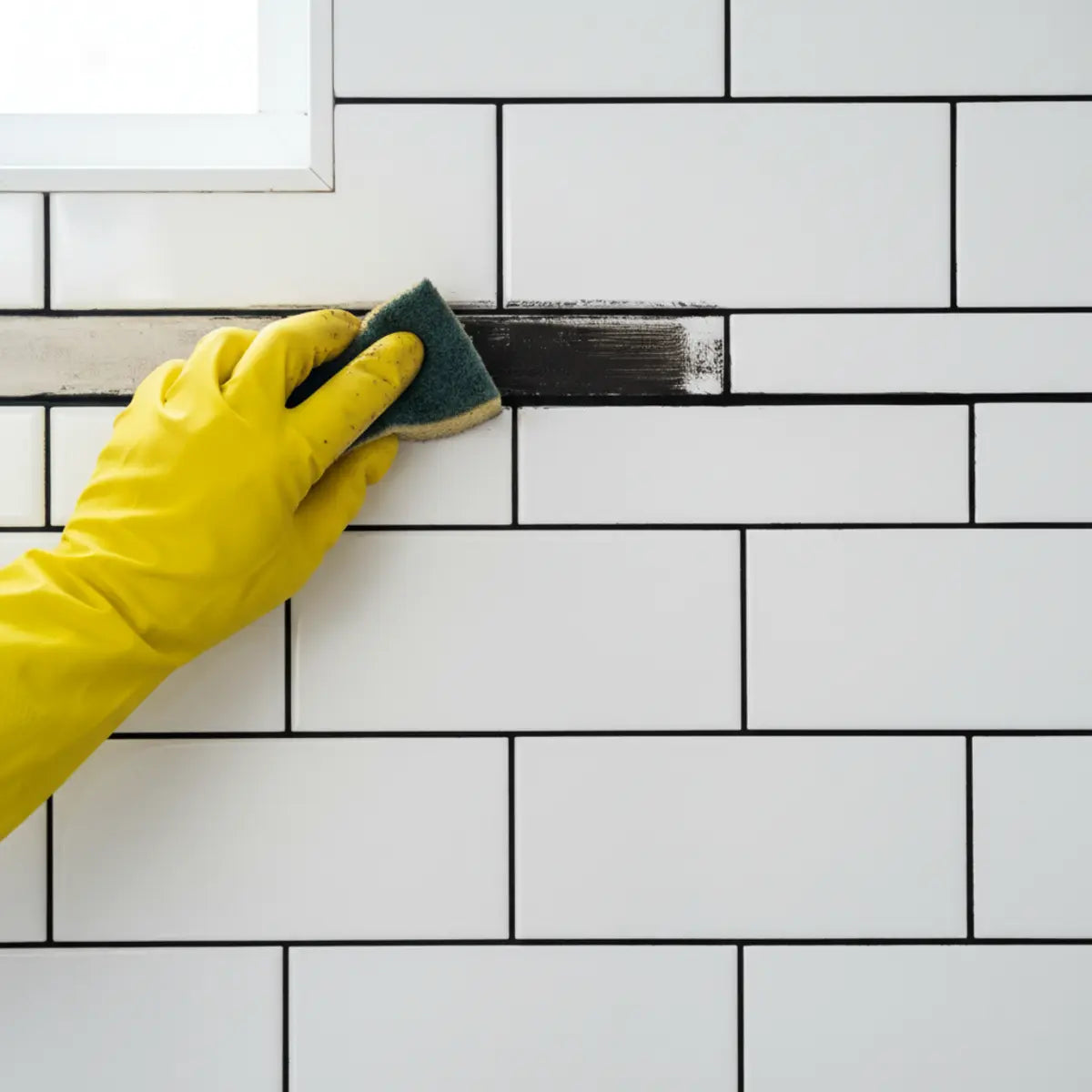
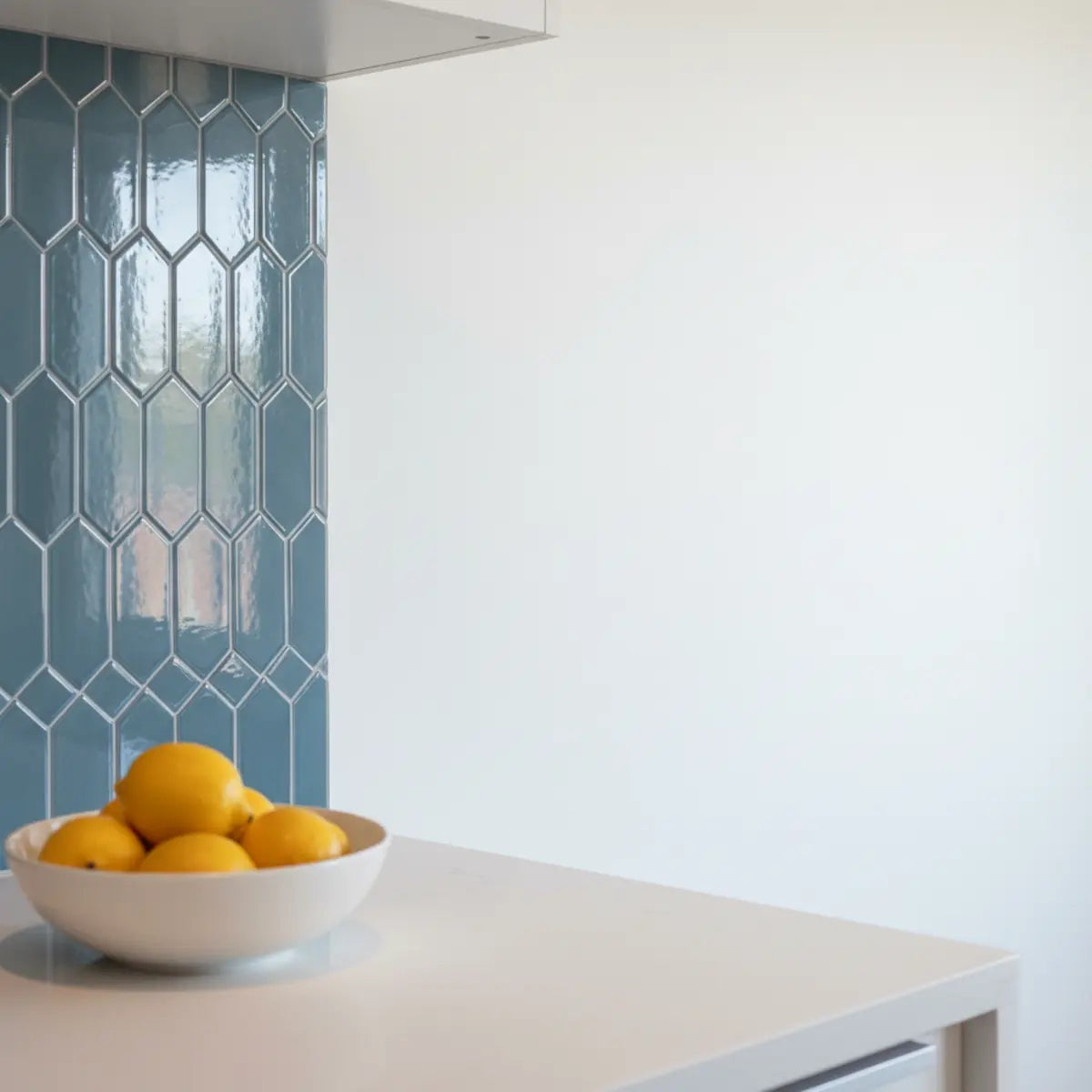

Hinterlasse einen Kommentar
Diese Website ist durch hCaptcha geschützt und es gelten die allgemeinen Geschäftsbedingungen und Datenschutzbestimmungen von hCaptcha.